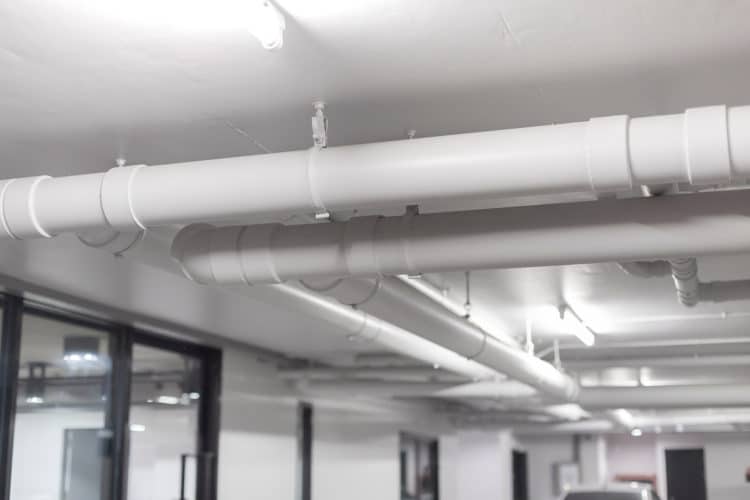When you create a lot of sawdust, investing in a powerful dust collector makes sense. You’ll create a healthier working environment while cutting down on potential flammables.
Dust collection systems should have enough airflow to produce 1,000 cubic feet per minute at each tool. That allows all the fine dust you created to get sent into a safe storage area.
Unless you plan to send a hose to each tool each time a cut is necessary, ductwork is required to draw the dust from each work area in the shop. This design ensures that everything goes to a centralized conductor.
A common material used for ductwork and plumbing in today’s homes is PVC. Since it has an explosive dust rating assigned to it, can you use it safely for dust collection systems?
Is PVC Pipe Safe to Use for a Dust Collection System?
PVC pipe is safe to use for dust collection systems. Although long stretches can cause static buildup that could create an ignition point with some flammables, the risk factors are minimal. The best option is to choose a smooth wall, keep distances short, and maintain direct connections.
When installing the ductwork for a dust collection system, you have two basic choices to consider. The material can be metal or PVC.
If you decide that metal is the best way to go, it should be a 26-gauge product or thicker to avoid potential collapsing problems when you introduce suction to the system.
It helps to use spiral pipes since it’s easy to seal and durable. Don’t use HVAC piping that you’ll find at most home improvement centers because it is a 30-gauge material that doesn’t have enough strength.
Since you’re using large pipes, it helps to buy local whenever possible when installing metal ductwork for collection systems.
If you prefer PVC for your ductwork needs, you’ll need to be aware that several different thickness options are on the market right now. I recommend going with the thinnest product you can find.
It’s typically ASTM pipe, but you can sometimes see it listed as a sewer and drain product.
Most garages don’t need an extensive collection system. If you’re only running a tool or two, the Central Vacuum Standard two-inch OD PVC pipe works well for your installation.
Each pipe length is just under six feet, making it suitable for installation without needing to cut anything except for the connection points.
When you have multiple stationary tools that require dust collection, you’ll need a four-inch PVC pipe to install. A six-inch pipe works better if you need to maximize airflow because of simultaneous operations.
Although metal and PVC work equally well, the latter tends to be the most affordable option in many communities and online.
What Dust Collection Options Are Available?
Dust collection tends to be a complicated science since everything requires customization. You can certainly purchase a central collector that delivers plenty of suction, but it’s up to you to design the ductwork that leads to your tool stations.
Instead of creating a complex guide that goes through every potential possibility, I recommend following the GOD methodology. Be gentle, open, and direct.
Gentleness is necessary because you want the dust to travel through the ducts smoothly. It helps to use smooth wall pipes, not the flexible kind with ridged sides, and make any turns gradual. That stops most clogs from happening.
Openness is an essential trait because small pipes create bigger problems. It helps to think of the ducts as the arteries for the collection system.
When they’re nice and large, the material has no problem flowing to its eventual home. If they’re constricted, you can give your shop a proverbial heart attack.
Directness is crucial because you want the ducts to run for as short a length as possible.
When you have a long pipe to use, the risk of high static pressure increases. That affects performance and highlights the explosive nature of some materials.
Does PVC Pipe Need to Be Grounded?
You won’t find a bigger debate on the Internet today than the one you’ll see when people answer this question. An actual fire from static discharge might have happened, but there isn’t a documented instance where it occurred because of the PVC.
That’s because the internal static doesn’t come to the outside of the pipe. Anything that builds up on the exterior doesn’t travel to the interior.
If you live in a dry climate, your dust collection system could deliver a static shock under the right conditions.
I’ve never grounded my PVC systems, and there has never been an issue that developed from my dust collection system.
Anyone who feels that grounding is necessary can run a line through the pipe with a fixed point to ensure the static has places to discharge.
How to Apply the GOD Methodology
When you’ve got the materials available to install your dust collection system, it’s time to evaluate your design using my GOD methodology.
Here’s a closer look at what that entails.
G Is for Gentleness
When running your PVC pipe (or alternative material), the goal should be to make gentle transitions across long distances. You don’t want to have the dust slowing as it goes around a curve or a corner.
Tight corners equate to constricted pipe spaces.
Instead of using a standard elbow bend, incorporate two 45-degree curves with a small section of straight pipe between them to handle faster turns. You can also try a long-sweep elbow, although they are uncommon to find today.
When connecting multiple lines to the system, use wyes instead of tees. There’s less construction at the joint by taking this step, even if it does require a little extra creativity to hook up some stations.
If you drop to a smaller duct size, use a reducer with a smooth taper. You’ll reduce turbulence in the pipe and improve the airflow.
Flex pipe is fine when you have no other option. Whenever you can avoid it, do so.
O is for Openness
When you think about dust collection, size matters. When the PVC pipe is too small, it won’t mode adequate air volumes to remove the fine dust particles. If your ductwork is too large, it won’t provide enough air to move anything.
That’s why your duct layout is a crucial component of your collection system.
After choosing a collection mechanism that delivers enough suction for your configuration, the most straightforward approach is to run a six-inch pipe wherever it works.
When needed, switch to a four-inch pipe and then drop to two inches for a single tool.
That means you might need to modify some dust ports on tools, but that effort isn’t difficult. Many products come with manufacturer’s instructions that take you step-by-step through the process.
D is for Directness
Dust collection ducts should run as straight and direct as possible. You only want a few turns to disrupt this process, even if that means you need to rearrange your tools or stations.
Keep the biggest dust producers close to the collection, such as your planer or a table saw. That allows the airflow to maximize the full potential of the PVC installation where you need it the most.
One common issue that some people face is the idea of running the ductwork around the perimeter of the space instead of directly to the station. That causes a longer run, more work, and can cause performance to suffer.
Other Ducting Solutions to Consider for Dust Collection
After you’ve secured your PVC pipe, the dust collection system, and your station setups, you might need to include any or all of the following suggestions to maximize your ducting.
| Ducting Suggestion | Why This Ducting Suggestion is Helpful |
| Seal the Joints | When using PVC, you don’t need to seal most of your joints. It tends to be necessary around your corner sweeps. You can apply it at all joints if you need some extra peace of mind. When using metal, every joint must be sealed to minimize leaks. |
| Add Screws | When using a vertical run, I like to put a couple of self-tapping screws into the joints that tend to be loose. If they need to be rearranged later, removing the extra security is a simple matter. |
| Extra Ports | Even if your dust collection system is for one tool, it might be helpful to set up an additional port at a logical location for another station. Taking this step speeds up your future installation work. A cap or a blast gate ensures you have an accessible site to use. |
| Attach to Studs | You never know what might happen in a garage or a shop. That’s why I like to connect my duct runs to studs in the wall or ceiling. I use a plumber’s strap with a standard drywall screw to create the extra security. As a general rule of thumb, I place a couple of straps about every ten feet or use one for a six-foot section. |
| Blast Gates | Most people advise that you should use the same material for this component as your ducting choice. I prefer to use metal ones with my PVC setup. The best one I’ve seen is the PowerTec 70227. It’s made from aluminum, uses a clog-proof groove design, and includes a locking stop to ensure the gate remains aligned. |
Is PVC Pipe the Best Option to Use for Dust Collection Systems?
PVC pipe is an excellent choice for ductwork while installing a dust collection system. It’s lightweight, strong, and easy to cut when specific lengths are necessary for an individualized setup.
Some dust collection systems have specific duct requirements that you must follow to use the equipment properly. Trust me on this – I found that out the hard way.
After installing my Supercell High-Pressure Dust Collector, I routed the ducts in the way that made the most sense for my shop. I grabbed that model because it works with tools that have port sizes ranging from one to five inches.
That’s when I found out it is meant to work with a single tool, not multiple duct stations, and works better with a flex pipe – not a smooth-sided PVC.
That was fine since all I had to do was take down the pipe holders from the studs, but it was a lesson on understanding what I was purchasing and why.
PVC pipe is safe to use in numerous applications. It is a low-risk solution that helps to create a cleaner environment.

